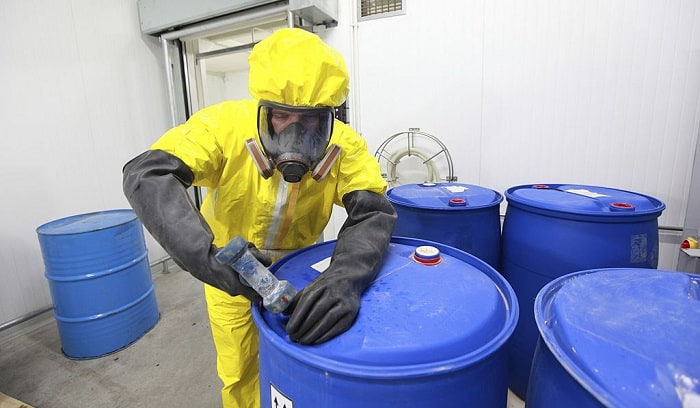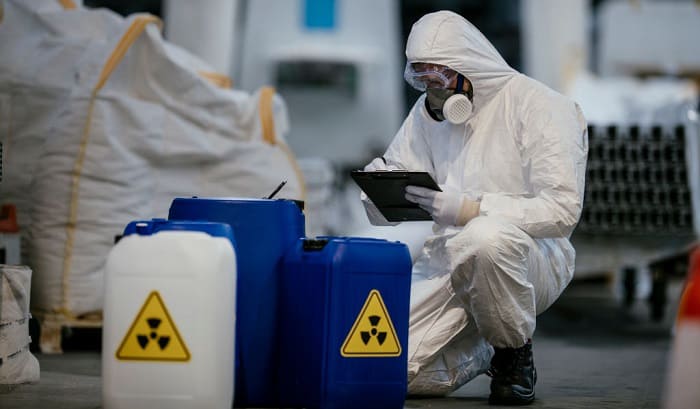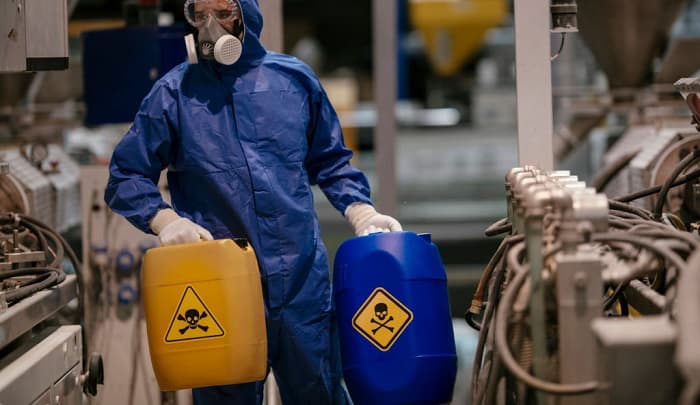When it comes to hazardous chemicals, you can’t mess around. Exposing your hands to harmful substances can cause long-term health issues, including dermatitis and cancer. Fortunately, workers can wear protective gloves to prevent most hand injuries, skin diseases, and exposures.
So, what type of gloves protects your hands from hazardous chemicals? There isn’t one simple answer for all. Selecting the appropriate chemical-resistant gloves involves more than just picking sizes, you also have to understand the chemical substances and working conditions. For example, PVA gloves keep your hands safe when contacting fuel but they melt when encountering water.
This article will explain seven common types of chemical-resistant gloves and teach you how to identify the proper ones for your jobs. Continue to explore the details!
Table of Contents
Identify the Chemical Hazards You Are Facing
A glove material can only protect against one or two chemicals. You need to identify the exact environment you will wear the gloves and choose the materials accordingly. OSHA’s PPE standard mandates employers to assess the working conditions, potential hazards, and durations of use to provide employees with the most appropriate chemical-resistant gloves.
Glove manufacturers and distributors categorize their chemical-protective gloves into classes. Knowing this is the first step to determining the type of gloves will protect your hands. Refer to the table below to see which class the substances you handle fall into.
You can download the Personal Protective Equipment Selection Guide for more chemical types, hazards, and recommended gloves.
Types of Chemical-resistant Gloves
Once you figure out the chemical hazards you have to deal with, match the chemicals to the best-suited glove material.
1. Latex
Latex, or natural rubber, is one of the most popular glove materials because it is inexpensive and widely available. It offers good strength and flexibility but minimal chemical resistance. Its application is limited to the food, aircraft assembly, automotive, and medical industry.
A downside is that latex can put wearers at risk of allergic reactions. In the healthcare profession, up to 12 percent of the staff report having latex allergies (Department of Health, New York). The reactions can be as mild as skin rashes or more serious as dermatitis, which leads to extreme discomfort and pain in the long run. If you have experienced this before, avoid latex gloves.
2. Nitrile
Nitrile provides good chemical resistance at a moderate price. Nitrile gloves protect against gasoline, kerosene, and most petroleum solvents, but not ketones, strong oxidizing acids, and nitrogen organic compounds. This rubber is also vulnerable to fire and flames.
As a result, nitrile gloves are for general around-the-plant work, painting environments, and automotive assembly. Also, nitrile gloves are resistant to oil and fats in the body. They are preferable in medical settings to promote a latex-free work condition.
3. Neoprene
Neoprene gloves are well-known for their excellent chemical resistance. Neoprene can maintain its flexibility and stability under a wide range of temperatures. It provides superior protection against acids, oils, inks, alcohols, and most organic harmful substances.
Some examples are pentachlorophenol, pentachloro naphthalene, and hydrazine. Moreover, it performs outstandingly in situations demanding grip and dexterity.
But the material has its drawbacks. It has high production costs and poor resistance to inorganic oxidizing agents, oils, and strong acids (e.g., chromic acids, concentrated nitric).
4. PVC (Vinyl)
Polyvinyl Chloride (PVC) is inexpensive, yet it provides high resistance to diluted oxidizing agents, many acids, caustics, alcohols, and bases. In addition, it can withstand abrasion and aging. In light industrial settings, where abrasion injuries are likely to happen, vinyl gloves are a good choice. However, PVC is susceptible to acetones, ether, ketones, aromatic or chlorinated substances.
5. PVA (Polyvinyl alcohol)
PVA gloves are used in numerous industries, including life science, furnace and lab equipment cleaning, and fuel transferring. Polyvinyl alcohol is impermeable to petrol and almost all chemicals. But it lacks resistance to water and water-based substances. On a humid day, PVA gloves might even dissolve.
Though manufacturers usually add coatings and knit lining to enhance the material’s endurance, we don’t recommend using it in water-based solutions.
6. Butyl
Butyl can resist methyl, acetone, and ethyl ketone. Thus, it is preferable in salons for external cosmetic procedures like eyebrow microblading, pedicure, and manicure. Another application of Butyl is for the oil and gas industry as this material is inert to chlorine gas and hydrogen cyanide.
7. Viton
Viton is one of the most costly polymers to produce. That is the main reason why it is not widely used despite its incredible resistance to chemicals and heat. It resists aromatic hydrocarbons like toluene, benzene, and xylene.
Due to the price, Viton’s application stays in expensive and demanding industries like aerospace and aircraft. It is also worn as lab safety gloves in aggressive chemical experiments.
Watch this video for more details of each glove type:
Precautions When Selecting Chemical-resistant Gloves
Nevertheless, you might risk choosing the wrong chemical gloves when you base solely on the materials. There are three reasons why:
- Different chemicals: The chemicals you use might be slightly different from the tested ones.
- Different concentrations and chemical solutions: Even when you use the tested chemical, you might risk putting it in a weaker or stronger chemical solution, which can drastically affect its breakthrough time.
- Mixtures of chemicals: You use a mixture of two or three substances but have the breakthrough time of them individually. Mixing chemicals together can entirely change their characteristics, so the PPE might fail to provide protection.
If you’re choosing chemical-resistant gloves for your workforce, it’s important to have the gloves tested against the specific chemicals that your workers interact with in an accredited laboratory.
Conclusion
Selecting chemical-resistant gloves requires a thorough understanding of the circumstances. Don’t fall for false beliefs like thicker gloves provides superior protection, or one certain type of gloves can be used against all chemicals. To sum up this article on what type of gloves protects your hands from hazardous chemicals, keep in mind these key points:
- Disposable latex gloves protect against dilute aqueous solutions of mild irritants (e.g., inorganic salt solution, alcohols).
- Disposable nitrile gloves are for dilute acid and base solutions, alcohols, aliphatic and aromatic hydrocarbons.
- Heavy-duty nitrile gloves are for corrosive or caustic acids and bases, aqueous halogens, ethers, and some chlorinated organics.
- Neoprene gloves protect against corrosive and oxidizing acids, caustic alkali, hydrocarbons, and alcohols.
- Butyl gloves are resistant to acids and bases, alcohols, ethers, ketone, and esters.

Veronica is our content editor. She is a talent in delivery. Her main work is editing and writing articles that are both informative and simple to follow. She is in charge of synthesizing our understanding of what personal protection equipment (PPE) is needed in each job, how to best apply it, and how to visualize that equipment.




